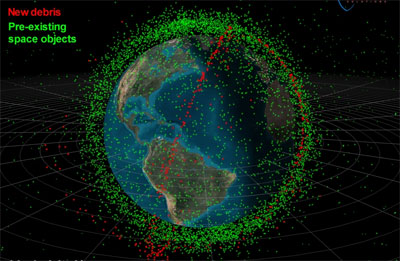 The graphic on the right shows just how much space junk there is, and what new bits have been added by the recent collision between Cosmos 2251 and Iridium 33.
The graphic on the right shows just how much space junk there is, and what new bits have been added by the recent collision between Cosmos 2251 and Iridium 33.Most space junk is small - flecks of paint and the like. But even they can make your eyes water when their relative velocity at collision is tens of kilometres per second. By comparison, a bullet travels at less than half a kilometre per second.
Such small things don't last long though. A 1/6 cubic meter satellite in orbit at 800km will re-enter in about a century, as although the atmosphere is so thin as to be almost a complete vacuum at that altitude, "almost" is the operative word. Smaller, lighter things in lower orbit decay faster. And every time the sun hiccups with a solar storm, the trace upper atmosphere expands outwards as it heats, and drag at low orbit increases dramatically. Mother Nature's orbital vacuum cleaner makes sure that small particles slow down, and as they slow, their orbit gets closer, so they enter even denser atmosphere, so slow even more, and soon they start heating up and evaporating.
I hope that in 50 or 60 years time, the older space debris will be recovered and sent back home to museums, just as aircraft from WW2 are recovered from frozen lakes and jungles today. As archaeological artefacts of great historical value. And incidentally, to remove a safety hazard.

2 comments:
With that closing paragraph, if you haven't seen the Planetes anime (or read the manga), you really ought to -- being the story of an orbital debris collector in the 2070s.
If we include all the new (and yet to come) offers for private space travel there might be more collisions than on the highway with the remaining debris and the new ones...
Post a Comment